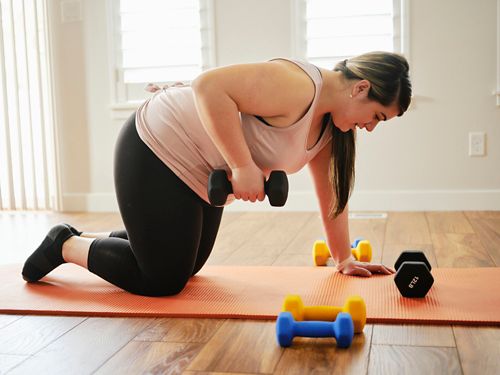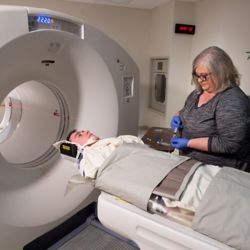Bone Health: How to Increase Bone Density
Think of someone with brittle and weak bones. Did you picture a hunched-over older person walking with a cane?
It’s true that many older people have weak bones, also known as osteoporosis or low bone density. In fact, about 4% of men and 19% of women over age 50 have osteoporosis. Having weak bones means you are more likely to break bones from a fall or accident.
But osteoporosis doesn’t only affect older people. Medicines and treatment for many illnesses can contribute to bone weakness in younger people. Childhood cancer survivors and children with sickle cell disease are at risk for poor bone health during and after treatment.

Long-term use of corticosteroids, such as prednisone or dexamethasone, and methotrexate cause bone weakness in some people. Radiation can also damage bones, especially when it’s a high dose or at a younger age.
Even if you are healthy, your bones get weaker with age. If you have weak bones after treatment, you could be at risk for poor bone health and fractures much sooner.
Factors other than treatment can cause bone weakness. Many children with cancer do not exercise as much as children without cancer because they don’t feel well. They also may not eat foods that can help build strong bones.
Young adults with sickle cell disease can have weak bones for similar reasons. But they also have high levels of proteins called inflammatory cytokines. These proteins can affect bone strength.
So, what can you do about weak bones after treatment for childhood cancer or sickle cell disease?
First, it’s important to talk to your doctor if you have questions about low bone density. Your doctor will know your past treatment and other risk factors that may affect your bone health.
Your doctor can order a test called a dual-energy X-ray absorptiometry (DEXA) or a computed tomography (CT) scan. The DEXA or CT scan use x-rays to measure bone density. They only take about 10–20 minutes and do not hurt. Once your doctor has your results, they can decide if you need treatment to help your bone strength.
Even if your doctor says your bone strength is good, you can still do a few things to help your bones stay strong. Here are a few recommendations for healthy bones.

Be active to build bone strength
Make movement a part of your everyday life. Try to do one hour of moderate to vigorous activity per day. Activities such as walking, riding a bike, or playing sports are great ways to do this. Exercises that mainly help strengthen bones include:
- Strength training
- Resistance training
- Plyometric activities such as jumping, hopping, and skipping
Muscles and bones get stronger in a similar way. Strengthening muscle helps our bones. Exercise puts stress on the muscles and bones. This is why you might feel tired after exercising. When you rest and recover, your body goes to work to repair the stress on the muscles and bones. This makes them stronger and allows you to be more active.
Teens and adults can build bone strength by lifting weights or playing sports. Younger children can make their bones stronger by playing, jumping, and running. It’s never too late to start exercising for bone health. But the sooner you start, the better.
Eat foods that support bone health
A registered dietician can help make sure that your diet supports your bone health. Visit the Academy of Nutrition and Dietetics Eat Right website to find a nutrition expert. Dietitians can ensure you are getting the right amount of energy to maintain a healthy weight for your age, sex, and height. Being underweight increases your risk for poor bone density.
Eat food rich in calcium and vitamin D.
- Calcium is a mineral that helps build bone strength. Milk, cheese, yogurt, dark green leafy vegetables, and calcium-fortified foods contain higher amounts of calcium.
- Vitamin D helps your body absorb the calcium. Some drinks like milk and orange juice also have extra vitamins. You can also eat salmon, tuna fish, or sardine.
Smoking harms bone health
Smoking is bad for your overall health. Here is how it can affect your bone density:
- The nicotine in cigarettes slows down the cells that build bones. This makes it harder for bones to stay strong.
- Smoking makes it difficult for your body to absorb calcium.
- Smoking can damage your blood vessels. Then your blood may not be able to deliver nutrients to your muscles and bones.
- Smoking causes inflammation. This affects the processes that help maintain bone strength and prevent fractures.
If you are a smoker, ask your care provider about resources and programs in your area to help you stop smoking.
Use a vibration plate to build bone strength
A vibration plate looks like a large bathroom scale that gives off low-magnitude, high-frequency vibration. When you stand on it, you may feel a soft vibration and hear a humming sound.
This device helps your bone strength much like exercise. You can stand on it for 20 minutes a day. But it takes a year or more to see results. The good news is this device may help increase bone strength in childhood cancer survivors with weak bones after treatment.
Vibration therapy could be a way to strengthen your bones, especially if you aren’t able to exercise. For more details, talk to your doctor or physical therapist.
Bone health is important to your overall health. Make sure you talk to your doctor about how to keep your bones healthy during and after treatment.





